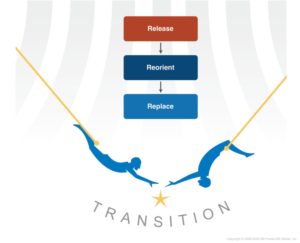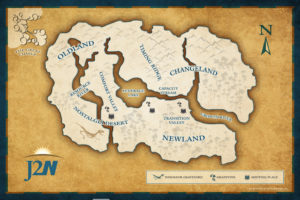Be prepared to lead transition phases by giving your team space and time to mentally and emotionally shift
Remember the trapeze artist visual in Part 1, The Difference Between Change and Transition? There is a state in between in which there is tension, risk, and adventure. At that point, the artist must let go and grasp the next swing or swing back to her original position. This trapeze artist example illustrates the three transition phases in the Journey to Newland roadmap.

- Release. You “end” your dependence on the old paradigm when you let go of the swing (Oldland). Up to this point and until letting go, there is much anxiety, fear, and anger. Now you have to choose what to give up. For example, you may finish your relationship with school or need to let go of an ineffective leadership style, like perfectionism. And if you don’t release, you will always return—all the way back to Oldland.
- Reorient. This pha
 se is where you are suspended in space and vulnerable. There can be uncertainty and a sense of losing control, being in a state of limbo and ambiguity (Transition Valley). To complete any transition, no matter what you feel you may gain, you always have to lose something. And with loss comes grief. So, you must reorient yourself and internalize the reality that you cannot return.
se is where you are suspended in space and vulnerable. There can be uncertainty and a sense of losing control, being in a state of limbo and ambiguity (Transition Valley). To complete any transition, no matter what you feel you may gain, you always have to lose something. And with loss comes grief. So, you must reorient yourself and internalize the reality that you cannot return.
William Bridges, Ph.D., the preeminent authority on change and transition and author of Managing Transitions, calls this the “neutral zone” and explains: “Welcome to the middle phase of the transition process . . . it is the neutral zone because it is a nowhere between two somewheres, and because while you are in it, forward motion seems to stop a while and you hang suspended between was and will be. All the old clarities break down, and everything is in flux. Things are up in the air. Nothing is a given anymore, and anything could happen. No one knows the answers: one person says one thing, and someone else says something completely different.”
- Replace. This phase replaces the old swing with the new, leaves the past, and grasps the future (Newland). You cannot go back now. This space is the new beginning, and at this point, transformation takes place! The butterfly has emerged, never again to be a caterpillar.
Understanding these three phases can help you lead your team through the transition. While you may have been working on this transition for some time, team members may need space and time to work through the transition phases. They may have left Oldland situationally but may still be catching up mentally or emotionally. Some never catch up, and it is usually in transition that some who started the journey may not make it to Newland.
Copyright © 2023 J2N Global







